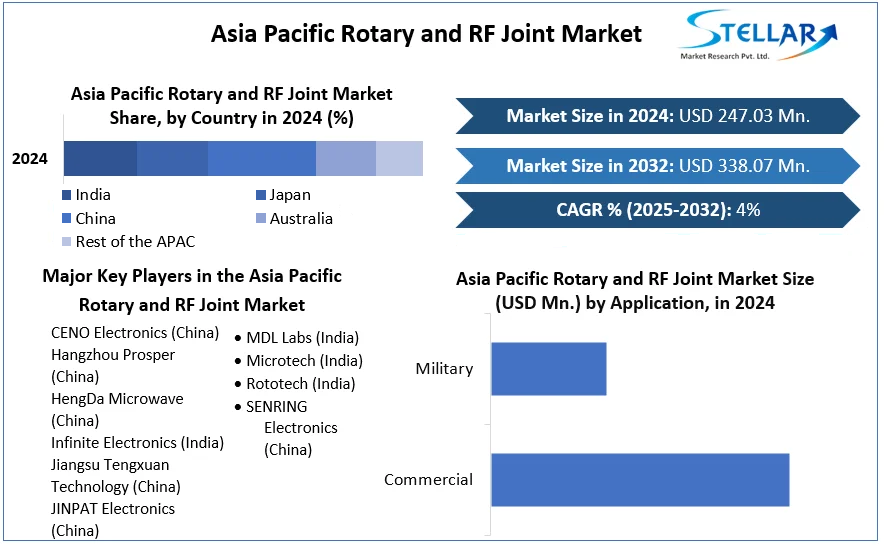Asia Pacific Rotary and RF Joint Market Industry Overview, Size, Share, Growth Trends, Research Insights and Forecast (2025–2032)
In 2024, the Asia Pacific Rotary and RF Joint Market was valued at USD 247.03 million and is expected to grow at a CAGR of 4 percent during the forecasting period (2025-2032)
Format : PDF | Report ID : SMR_725
Asia Pacific Rotary and RF Joint Market Overview
The technological advancements in oil and gas, manufacturing, aerospace, and food industries have promoted automation in the Asia Pacific region. The Asia Pacific automation market is expected to grow at a CAGR of 10.32 percent during the forecast period stimulating growth opportunities for the Rotary and RF Joint market.
The COVID-19 outbreak has significantly influenced the rotary and RF rotary joint markets. Various parts of Asia Pacific have been moderately affected by the pandemic, and governments in these countries have responded effectively. The production industry has faced significant challenges as the COVID-19 pandemic has spread over parts of developing Asia. In 2020, factory production fell drastically across most Asia as the coronavirus epidemic froze global economic activity, with sharp drops in export powerhouses Japan and South Korea eclipsing a minor improvement in China.

To get more Insights: Request Free Sample Report
Asia Pacific Rotary and RF Joint Market Dynamics:
The growth of the manufacturing industry in the Asia Pacific:
Since September 2020, the manufacturing sector in many Asia-Pacific (APAC) economies has seen a substantial comeback since lockdown measures in many countries have been curbed as the pandemic stabilizes slowly. While new waves of Covid-19 instances have emerged in several Asian countries, including Japan and Malaysia, the overall momentum of manufacturing output in the region has demonstrated a significant rebound.
In January, mainland China's auto sector saw another month of a substantial increase in new vehicle sales, demonstrating strong demand for both passenger and commercial cars. According to the China Association of Automobile Manufacturers (CAAM), recent wholesale vehicle sales in mainland China surged by 29.5 percent year over year to 2.503 million units in January, while manufacturing increased by 34.6 percent to 2.388 million units.
The IoT integration in the manufacturing industry has enabled manufacturers to increase production, reduce costs and delivery time and offer customized products as demanded by developed countries. The Asia Pacific market for IoT in the industrial sector was valued at USD 15.48 billion in 2020 and is expected to increase, stimulating the Rotary and RF Joint market.
Satellite Navigation:
The primary usage of satellite navigation was introduced and built for military applications to allow accurate target delivery in critical operations. These key developments are expected to boost demand for navigation satellites in the coming years. In 2019, the Satellite navigation market was valued at USD 49.32 billion and is expected to reach USD 99.32 billion by 2030.
A satellite navigation system employs satellites to offer autonomous geospatial positioning, a satnav system. It uses time signals delivered along a line of sight by satellites to let tiny electronic receivers determine their location with great precision. The system can provide position, navigation, or track the location of something that has a receiver attached to it. The signals also enable the electronic receiver to calculate the current local time to high precision, allowing for time synchronization.
The budget feasibility assessment for the Korea Positioning System (KPS) proposal passed in June 2021 opened the way for a KRW 3.72 trillion (USD 3 billion) project by the Ministry of Science and ICT (MSIT). Next year, the project will commence with the plan to launch eight satellites (3 GEOs, 5 IGSOs) by 2035. Taiwan is attempting to establish a key place in the space industry's supply chain by using its competitive semiconductor and precision manufacturing capabilities.
Asia Pacific Rotary and RF Joint Market Segment Analysis:
The Asia Pacific Rotary and RF Joint market is segmented by product type, application, end-use industry, and geographical region. The Asia Pacific Rotary and RF Joint market by Product type is segmented into Single Passage Rotary Joints, Multi Passage Rotary Joints, Wave Guided RF Rotary Joints, Coaxial RF Rotary Joints, and Hybrid RF Rotary Joints.
Waveguide rotary joints (WRJs) are waveguide components that transfer microwave energy from stationary to rotating lines, also known as Rotating couplers and RF rotary joints. Two waveguide-to-coaxial transitions are connected by a coaxial cable to form waveguide rotary joints. The WRJ may revolve around this coaxial line without hurting performance because it's spherical. Two coaxial cables can be put into the hollow inner conductor of the coaxial line to create dual-channel waveguide rotary joints.
With the adoption of smart cities, new industrial projects, and energy generation, the commercial and industrial applications of Asia Pacific Rotary and RF Joint are expected to grow. The demand for power distribution in developing countries is predicted to increase as rural regions undergo development.

In 2024, China was the major exporter of transformer Asia Pacific Rotary and RF Joint Market, holding 14 percent of the market share, followed by India. Hong Kong showed the quickest growth rate for exporting Asia Pacific Rotary and RF Joint equipment.
Asia Pacific Rotary and RF Joint Market Regional Analysis:
The report contains an in-depth analysis of the Asia Pacific Rotary and RF Joint market by geographical region across Asia-Pacific. The presence of developing countries like India and China is expected to drive the Asia Pacific Rotary and RF Joint market growth in this region. During the COVID-19 pandemic, APAC's semiconductor manufacturing countries and China pioneered the development of medical equipment in the area. Further, Korea is developing the space sector by investing substantially in space programs such as launch vehicles, a regional satellite navigation system (KPS), as well as a lunar exploration mission (total investment > USD 4.28 billion). The Korean New Deal encompasses megatrends such as digitalization, data, artificial intelligence, and climate change, all of which rely on GNSS-powered solutions such as autonomous driving, shipping, and smart cities.
This report aims to analyze current market trends and potential opportunities to enhance growth to succeed in the industry. The report identifies factors influencing market dynamics and development of the Asia Pacific Rotary and RF Joint market and how this will control investment during the forecasting period. The report studies regional markets to provide valuable insights into revenue and predicted value; information also includes the competitive landscape of key industry players and their recent developments.
Through comprehensive research supported by qualitative and quantitative data, this report provides essential information on the market behavior during the projection period (2025-2032). It also recognizes dominant segments in the market, projects their development, and identifies new elements that will dominate with technological advancements.
The report contains detailed analyses through Porter's five forces model to determine the industry's structure and help devise a corporate strategy for the market. The model reports provide essential information about stakeholders' influence, product quality, substitute products, etc. The report also analyses whether the Asia Pacific Rotary and RF Joint market is accessible for new competitors to gain a foothold, whether they enter or exit the market regularly, and if a few players dominate it.
A measured approach is adopted through Pestel analysis to quantify factors including government policies, economic structure, and political situations that will affect the development of this sector. Economic variables aid in studying financial performance drivers that impact the Asia Pacific Rotary and RF Joint Market. The report also considers environmental and legal factors that may affect the progress in this industry.
Asia Pacific Rotary and RF Joint Market Scope
|
Asia Pacific Rotary and RF Joint Market |
|
|
Market Size in 2024 |
USD 247.03 Mn |
|
Market Size in 2032 |
USD 338.07 Mn |
|
CAGR (2025-2032) |
4 % |
|
Historic Data |
2019-2024 |
|
Base Year |
2024 |
|
Forecast Period |
2025-2032 |
|
Segment Scope |
By Product type
|
|
By Application
|
|
|
Country Scope |
China India Japan South Korea Australia ASEAN Rest of APAC |
Asia Pacific Rotary and RF Joint Market Major Players
The Asia Pacific Rotary and RF Joint demands innovation and progress in a continuously changing landscape with new government policies and development. Thus, significant players often opt for strategies to invest in research and more recent technologies to be market-ready. Details profiles about the competitors, including revenue, market size, analysis, and technological advancements, are covered in this report.
- CENO Electronics (China)
- Hangzhou Prosper (China)
- HengDa Microwave (China)
- Infinite Electronics (India)
- Jiangsu Tengxuan Technology (China)
- JINPAT Electronics (China)
- MDL Labs (India)
- Microtech (India)
- Rototech (India)
- SENRING Electronics (China)
Frequently Asked Questions
China is projected to multiply and acquire a major share in the forecasting period.
Asia Pacific Rotary and RF Joint market is expected to grow at a CAGR of 4 % during the forecasting period.
Microtech (India), Rototech (India), MDL Labs (India), SENRING Electronics (China) the major players.
The Asia Pacific Rotary and RF Joint Market size was USD 247.03 Mn. in 2024.
- Scope of the Report
- Research Methodology
- Research Process
- Global Asia Pacific Rotary and RF Joint Market: Target Audience
- Global Asia Pacific Rotary and RF Joint Market: Primary Research (As per Client Requirement)
- Global Asia Pacific Rotary and RF Joint Market: Secondary Research
- Executive Summary
- Competitive Landscape
- Key Players Benchmarking: by Product, Pricing, Investments, Expansion Plans, Physical Presence, and Presence in the Market.
- Mergers and Acquisitions in Industry: M&A by Region, Value, and Strategic Intent
- Market Dynamics
- Market Drivers
- Market Restraints
- Market Opportunities
- Market Challenges
- PESTLE Analysis
- PORTERS Five Force Analysis
- Value Chain Analysis
- Asia Pacific Rotary and RF Joint Market Segmentation
- Asia Pacific Rotary and RF Joint Market, by Equipment Type (2024-2032)
- Single Passage Rotary Joints
- Multi Passage Rotary Joints
- Wave Guided RF Rotary Joints
- Coaxial RF Rotary Joints
- Hybrid RF Rotary Joints
- Asia Pacific Rotary and RF Joint Market, by Application (2024-2032)
- Commercial
- Military
- Asia Pacific Rotary and RF Joint Market, by End-Use Industry (2024-2032)
- Aerospace
- Food & beverages
- Industrial Automation
- Oil & gas
- Semiconductors
- Energy
- Medical
- Asia Pacific Rotary and RF Joint Market, by Country (2024-2032)
- China
- India
- Japan
- Asia Pacific Rotary and RF Joint Market, by Equipment Type (2024-2032)
- Company Profiles
- Key Players
- ApiTech(India)
- Company Overview
- Product Portfolio
- Financial Overview
- Business Strategy
- Key Developments
- CENO Electronics (China)
- Hangzhou Prosper (China)
- HengDa Microwave (China)
- Infinite Electronics (India)
- Jiangsu Tengxuan Technology (China)
- JINPAT Electronics (China)
- MDL Labs (India)
- Microtech (India)
- Rototech (India)
- SENRING Electronics (China)
- ApiTech(India)
- Key Players
- Key Findings
- Recommendations
















